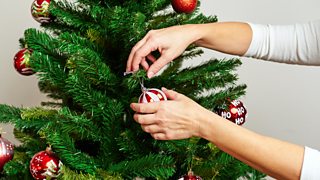Should you buy a real or artificial Christmas tree this year?
Everyone loves the smell of a freshly cut Christmas tree, but the vast majority of them get thrown away or taken to the tip. So, would a plastic tree be better for the environment?
Listener Eleanor wants to have a more sustainable Christmas and has some great questions. What's the best way to dispose of a real tree? Should she get a 'pot-grown' tree to use next year? She's even heard about renting the same tree year after year – is that really a thing?
In a festive episode of 91热爆 Radio 4's Sliced Bread, presenter Greg Foot attempts to get to the root of the problem by speaking to an ecological expert and a journalist who's attempted to rent the whole of Christmas.
Here's what Eleanor needs to consider before buying her next Christmas tree…

Getting a real tree doesn't involve 'deforestation'
When you buy a real Christmas tree, you don't need to worry about deforestation because they're grown on purpose-built farms. “They are grown on land that didn't have forest before, so in that sense it’s not deforestation,” explains Dr Paul Caplat, an ecologist at Queen's University Belfast. However, “we could decide to rewild entire areas with natural forest and that could be better than growing Christmas trees,” suggests the ecologist.
And, to keep your tree's carbon footprint down, make sure it wasn't grown on wet peatland that’s been drained to create a tree plantation. (A well-functioning peatland is a brilliant carbon sink, pulling carbon out of the atmosphere.)
Going organic is much better for the environment
A UK-grown tree will have started in a nursery where there will have been some kind of control for temperature or humidity – but the carbon created will be minimal. The planting itself will emit some carbon, but that's also very small. Then when growing, the tree will absorb a lot of carbon out of the atmosphere.
How a Christmas tree is managed while it's growing will all have an impact on how environmentally friendly it is.
However, how the tree is managed while it's growing will all have an impact on how green it is, explains Dr Caplat. Pesticides are used when trees are grown intensively on a farm because this high density of the same species (monoculture) makes them more sensitive to pathogens.
“An organic Christmas tree won't have chemical pesticides used, or very little,” he states and this is “way better”. It's better for the environment, has a less adverse effect on local insect populations, and also keeps the tree's carbon footprint down – because producing pesticides and fertilisers requires a lot of energy. However, organic trees can be harder to find than the non-organic variety.
Buying a locally sourced tree is better for its carbon footprint
Once cut, the tree needs to get to the consumer. Depending on how far it has to travel, that could be a really large carbon footprint or a smaller one. “A local tree will have a smaller carbon footprint because it travels less of a distance,” explains Dr Caplat.
The British Christmas Tree Growers Association have labels that say where the trees are grown, and a lot of sellers will now promote the fact they're selling locally grown trees.
Look for an FSC label
An FSC label – which stands for Forest Stewardship Council – covers the basics of ethical and sustainable production, says Dr Caplat. “They don't go very far necessarily but they make sure that the trees are grown in the right conditions.”
Trees sold in pots are not the same as trees grown in pots
Some trees sold in pots were actually grown in the ground and just put in a pot at the last minute. These are not likely to be very long-lived, explains Dr Caplat.
Some trees sold in pots were actually grown in the ground and just put into a pot at the last minute.
But there are also 'pot-grown' trees available and they are much better because “their whole biology has adapted to growing in these conditions,” explains the ecologist. “That means that they can stay alive longer in a pot, which means that you can reuse them.” With luck, they can be kept in the garden throughout the year and live to see another Christmas.
How your tree ends its life has a huge impact on its carbon footprint
Disposing of a tree by burning it means that all the carbon that was captured while it was growing will go straight back into the atmosphere.
Some councils offer a tree recycling service or, alternatively, if you have a green waste bin you could chop up your real tree and dispose of it there.
But for the majority of us, the main option is to take it to your local tip. But, warns Dr Caplat, that could be worse than burning it. “Putting it in the landfill is actually even worse,” he explains. “The same thing happens [to the carbon release] but slowly, and during that time microorganisms decompose the wood and their activity releases even more greenhouse gasses.”
“The best way to dispose of it would probably be to chip it and use it as mulch,” he suggests. By integrating it into the soil, microorganisms make it into even smaller fragments and the carbon gets captured in the soil. The result is 'long-term carbon storage'.
A tree that's grown, chopped down and disposed of in landfill will have a carbon footprint of about 16 kilos. If you chip it and use it as mulch, that reduces the carbon footprint to (a not insignificant) 3.5 kilos.
You need to use an artificial tree for a decade to make it as green as a real tree
Plastic is made mostly from petrol, so that has a huge carbon impact, says Dr Caplat. Then there's transportation on top, so where a fake tree is manufactured will heavily impact its carbon footprint.

To make the carbon footprint of a fake tree lower than a real one, you'd have to use it for more than a decade.
The Carbon Trust has come up with an estimated figure of 40 kilos for an artificial tree, “so that's a lot more than a naturally grown tree,” says the ecologist. In order to make the footprint lower than a real tree, you have to dust off and reuse your artificial tree for more than a decade.
An artificial tree is more cost efficient than a cut tree
One downside to a real tree is the cost. A 6ft cut real tree comes in at around £40 to £60. A 6ft plastic tree is around £100 to £200, so you'd only need to use it for a few years to be in profit.
“But, depending on the cost of buying a tree in a pot – that would stay in the pot and live for a few years – that could be cheaper and better for the environment,” says Dr Caplat.
You can rent the same tree year after year – and give it a name
There are now companies that offer rented Christmas trees. They deliver them to your door, collect them when the festive season is over, and put them back in the soil for the rest of the year. “If that’s done correctly then that means that the tree has several years to live healthily and capture carbon during that time,” says Dr Caplat.
Telegraph features writer Anna Tyzack gave it a go. “I tried it and had a beautiful spruce delivered… and it really smelt amazing because it's obviously alive,” she says. Some people even name their tree, which they welcome back into their home each year. For city dwellers, without space for a potted tree in the garden, it's a great green option.
But you need to be quick off the mark: “It's a highly competitive market – they sell out very fast,” says Anna. And your time with your tree is limited – after three and a half weeks they need to be back out in the field.
Cost is another consideration. In London, it worked out fractionally more expensive to rent a tree, but in places where cut trees are cheaper, it would be considerably more expensive to rent. It’s a hefty price for sustainability – but the feel-good factor might just make it worth it.
To find out what Eleanor decides to do with Greg's findings – go for a cut, potted, fake or rented tree – listen to the full episode here.
The information contained in this article was correct at the time of broadcast on 30 November, 2023.

More from 91热爆 Radio 4
-
![]()
Are ice water baths really that good for us?
Examining the health benefits of dipping into ice cold water.
-
![]()
What's the best way to heat your room?
Greg Foot puts some portable home heaters to the test.
-
![]()
Are these 'must-have' gadgets worth buying?
Sliced Bread asseses the effectiveness of air fryers, massage guns and more.
-
![]()
Cold Therapy - with Michael Mosley
Listen to the series uncovering the surprising power of the cold to enhance your health.





